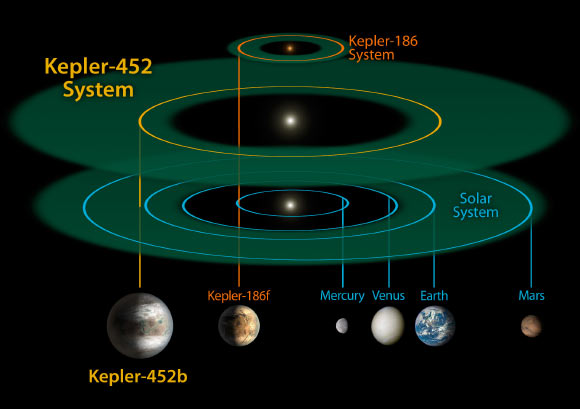Using NASA’s Kepler Space Telescope, astronomers have discovered a super-Earth exoplanet in the ‘habitable zone’ of a G2-type star called Kepler-452.

This artist’s concept depicts one possible appearance of the planet Kepler-452b, the first near-Earth-size world to be found in the habitable zone of star that is similar to our Sun. The habitable zone is a region around a star where temperatures are right for water – an essential ingredient for life as we know it – to pool on the surface. The astronomers do not know if Kepler-452b can support life or not. Image credit: NASA Ames / JPL-Caltech / T. Pyle.
The Kepler-452 system is located in the constellation Cygnus, approximately 1,400 light-years away.
It’s estimated that the star itself is approximately 6 billion years old – 1.5 billion years older than our Sun. The star has the same temperature (5,757 K), and is 20% brighter and has a diameter 10% larger.
The newfound planet, named Kepler-452b, is around 60% larger in diameter than Earth and is 5% farther from its parent star than Earth is from the Sun.
The planet has an orbital period around 385 days (only 5% longer than an Earth year).
“We can think of Kepler-452b as an older, bigger cousin to Earth, providing an opportunity to understand and reflect upon Earth’s evolving environment,” said Dr Jon Jenkins of NASA’s Ames Research Center, team member and lead author of the discovery paper published in the Astronomical Journal.
“It’s awe-inspiring to consider that this planet has spent 6 billion years in the habitable zone of its star; longer than Earth. That’s substantial opportunity for life to arise, should all the necessary ingredients and conditions for life exist on this planet.”
The discovery and confirmation of Kepler-452b brings the total number of confirmed exoplanets to 1,030.

This size and scale of the Kepler-452 system compared alongside the Kepler-186 system and the Solar System. Kepler-186 is a miniature solar system that would fit entirely inside the orbit of Mercury. The habitable zone of Kepler-186 is very small compared to that of Kepler-452 or the Sun because it is a much smaller, cooler star. The size and extent of the habitable zone of Kepler-452 is nearly the same as that of the Sun, but is slightly bigger because Kepler-452 is somewhat older, bigger and brighter. The size of the orbit of Kepler-452b is nearly the same as that of the Earth at 1.05 AU. Kepler-452b orbits its star once every 385 days. Image credit: NASA Ames / JPL-CalTech / R. Hurt.
In addition to this discovery, Dr Jenkins and co-authors have increased the number of planet candidates by 521 from their analysis of observations conducted from May 2009 to May 2013, raising the number of exoplanet candidates detected by Kepler to 4,696.
Twelve of the new candidate exoplanets have diameters 1-2 times that of Earth, and orbit in their star’s habitable zone. Of these, nine orbit stars that are similar to our Sun in size and temperature.
“We’ve been able to fully automate our process of identifying planet candidates, which means we can finally assess every transit signal in the entire Kepler dataset quickly and uniformly,” said co-author Dr Jeff Coughlin of the SETI Institute in Mountain View, California.
“This gives astronomers a statistically sound population of planet candidates to accurately determine the number of small, possibly rocky planets like Earth in our Milky Way Galaxy.”
_____
Jon M. Jenkins et al. 2015. Discovery and Validation of Kepler-452b: A 1.6 RO Super Earth Exoplanet in the Habitable Zone of a G2 Star. Astronomical Journal 150, 56; doi: 10.1088/0004-6256/150/2/56







